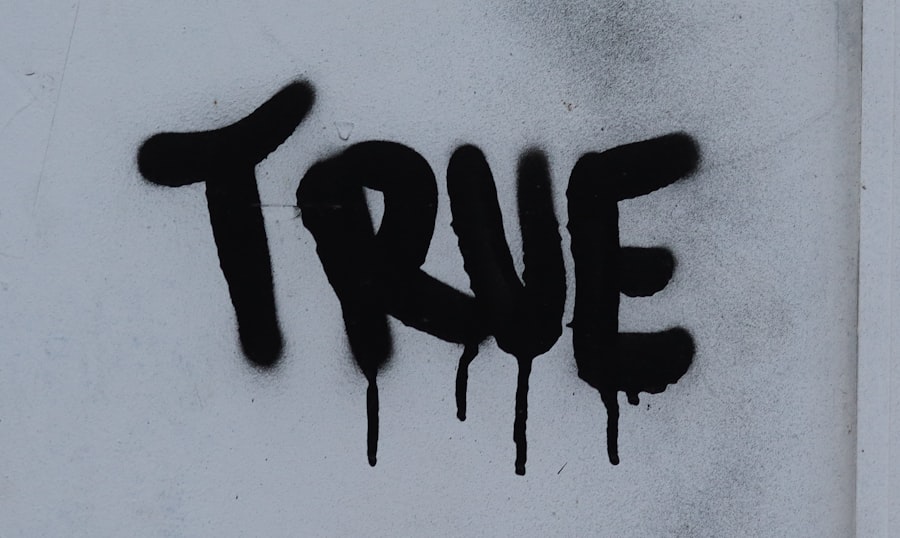Seeing clearly is not merely about having perfect vision; it encompasses the ability to perceive the world around you with clarity and understanding. In a world filled with information, opinions, and distractions, the importance of clear perception cannot be overstated. When you see clearly, you are better equipped to make informed decisions, engage in meaningful conversations, and navigate the complexities of life.
This clarity allows you to discern truth from falsehood, enabling you to build a solid foundation for your beliefs and actions. Moreover, seeing clearly fosters personal growth and development. It encourages you to reflect on your experiences and learn from them, rather than simply accepting things at face value.
By cultivating a clear perspective, you can identify your strengths and weaknesses, set realistic goals, and pursue them with determination. This journey toward clarity not only enhances your understanding of the world but also empowers you to take control of your life and make choices that align with your values and aspirations.
Key Takeaways
- Seeing clearly is essential for making informed decisions and understanding the world around us.
- Distortions in perception can lead to biased thinking and decision-making.
- Overcoming confirmation bias is crucial for seeking out and considering alternative viewpoints.
- Seeking multiple perspectives helps to gain a more comprehensive understanding of a situation or issue.
- Questioning assumptions is a key part of critical thinking and can lead to more accurate conclusions.
Recognizing Distortions in Perception
Recognizing distortions in perception is a crucial step toward achieving clarity. Your mind is often influenced by various factors that can skew your understanding of reality. These distortions can arise from personal biases, societal influences, or even emotional states.
By becoming aware of these distortions, you can begin to untangle the web of misconceptions that may cloud your judgment. This awareness allows you to approach situations with a more open mind, enabling you to see things as they truly are rather than how you wish them to be. To effectively recognize these distortions, it is essential to engage in self-reflection.
Take the time to examine your thoughts and feelings critically. Ask yourself why you perceive things in a certain way and whether those perceptions are based on facts or assumptions. By doing so, you can identify patterns in your thinking that may lead to distorted views.
This process not only enhances your self-awareness but also equips you with the tools needed to challenge and correct these distortions when they arise.
Overcoming Confirmation Bias

Confirmation bias is a pervasive cognitive phenomenon that can significantly hinder your ability to see clearly. It refers to the tendency to seek out information that confirms your existing beliefs while ignoring or dismissing evidence that contradicts them. This bias can create an echo chamber where your views are reinforced, leading to a distorted understanding of reality.
To overcome confirmation bias, it is essential to actively seek out diverse viewpoints and challenge your own beliefs. One effective strategy for overcoming confirmation bias is to engage in constructive dialogue with others who hold differing opinions. By listening to their perspectives, you can gain insights that may challenge your preconceived notions.
Additionally, consider exposing yourself to a variety of sources of information, including those that may not align with your beliefs. This practice encourages critical thinking and helps you develop a more nuanced understanding of complex issues. Ultimately, overcoming confirmation bias requires a commitment to intellectual humility and a willingness to embrace uncertainty.
Seeking Multiple Perspectives
| Team Member | Perspective Shared | Impact on Decision Making |
|---|---|---|
| John | Technical viewpoint | Improved solution efficiency |
| Sarah | Customer experience | Enhanced user satisfaction |
| Michael | Financial analysis | Cost-effective strategies |
In your quest for clarity, seeking multiple perspectives is invaluable. The world is rich with diverse experiences and viewpoints, each offering unique insights into various issues. By actively seeking out these perspectives, you can broaden your understanding and challenge your assumptions.
This practice not only enhances your critical thinking skills but also fosters empathy and compassion for others. When engaging with multiple perspectives, it is essential to approach discussions with an open mind. Listen actively and strive to understand the reasoning behind differing viewpoints.
This does not mean you must agree with every perspective; rather, it allows you to appreciate the complexity of human thought and experience. By incorporating diverse viewpoints into your understanding, you can develop a more comprehensive view of the world that transcends simplistic binaries.
Questioning Assumptions
Questioning assumptions is a fundamental aspect of critical thinking that can lead to greater clarity in your perception. Assumptions are often taken for granted, yet they shape how you interpret information and interact with the world. By challenging these assumptions, you can uncover hidden biases and beliefs that may be influencing your thoughts and actions.
To effectively question your assumptions, start by identifying them explicitly. What beliefs do you hold about yourself, others, or the world around you? Once you have articulated these assumptions, consider their validity.
Are they based on evidence or mere speculation?
By questioning assumptions, you create space for growth and learning, allowing for a more nuanced understanding of complex issues.
Identifying Cognitive Biases

Cognitive biases are systematic patterns of deviation from norm or rationality in judgment. They can significantly impact how you perceive information and make decisions. By identifying these biases within yourself, you can take proactive steps to mitigate their effects on your thinking.
Common cognitive biases include anchoring bias, availability heuristic, and overconfidence bias, among others. To identify cognitive biases in your thinking, it is helpful to familiarize yourself with their characteristics. For instance, anchoring bias occurs when you rely too heavily on the first piece of information encountered when making decisions.
By recognizing this tendency in yourself, you can consciously seek out additional information before forming conclusions. Similarly, being aware of the availability heuristic—where recent or memorable events disproportionately influence your judgment—can help you evaluate situations more objectively. By actively identifying cognitive biases, you empower yourself to make more rational decisions based on evidence rather than flawed reasoning.
Understanding the Influence of Emotions
Emotions play a significant role in shaping your perceptions and decision-making processes. While emotions are a natural part of being human, they can sometimes cloud your judgment and lead to distorted views of reality. Understanding the influence of emotions on your thinking is crucial for achieving clarity in perception.
When faced with strong emotions—such as anger, fear, or joy—take a moment to pause and reflect on how these feelings may be influencing your thoughts. Are you reacting impulsively based on emotion rather than rational analysis? By acknowledging the impact of emotions on your perceptions, you can create space for more thoughtful responses.
This practice allows you to separate emotional reactions from objective assessments, leading to clearer thinking and better decision-making.
Practicing Critical Thinking
Critical thinking is an essential skill that enables you to analyze information objectively and make reasoned judgments. It involves evaluating evidence, identifying logical fallacies, and considering alternative viewpoints. By practicing critical thinking regularly, you can enhance your ability to see clearly and navigate complex issues with confidence.
To cultivate critical thinking skills, start by asking probing questions about the information presented to you. What evidence supports this claim? Are there any logical inconsistencies?
Engaging in discussions that challenge your thinking can also be beneficial; seek out opportunities for debate or dialogue with others who hold differing opinions. Additionally, consider keeping a journal where you reflect on your thoughts and analyze them critically over time. This practice not only sharpens your analytical skills but also encourages self-reflection and personal growth.
Distinguishing Facts from Opinions
In an age where information is abundant yet often misleading, distinguishing facts from opinions is vital for clear perception. Facts are objective statements supported by evidence, while opinions are subjective interpretations shaped by personal beliefs or feelings. Being able to differentiate between the two allows you to evaluate information critically and make informed decisions.
To effectively distinguish facts from opinions, consider the source of the information presented to you. Is it backed by credible evidence? Are there references or data supporting the claims made?
Additionally, be wary of emotionally charged language that may indicate an opinion rather than an objective fact. By honing this skill, you empower yourself to navigate the complexities of information consumption more effectively and develop a clearer understanding of the issues at hand.
Embracing Uncertainty
Embracing uncertainty is an essential aspect of achieving clarity in perception. The world is inherently complex and unpredictable; accepting this reality allows you to approach situations with an open mind rather than clinging rigidly to preconceived notions. Embracing uncertainty fosters resilience and adaptability—qualities that are invaluable in navigating life’s challenges.
When faced with uncertainty, practice mindfulness techniques such as deep breathing or meditation to ground yourself in the present moment. This practice helps reduce anxiety associated with uncertainty and encourages a more balanced perspective. Additionally, remind yourself that uncertainty often presents opportunities for growth and learning; by remaining open to new experiences and ideas, you can cultivate a richer understanding of the world around you.
Applying the Scientific Method
The scientific method is a systematic approach to inquiry that emphasizes observation, experimentation, and evidence-based reasoning. By applying this method in your daily life, you can enhance your ability to see clearly and make informed decisions based on empirical evidence rather than speculation or bias. To apply the scientific method effectively, start by formulating a clear question or hypothesis about a particular issue or phenomenon.
Next, gather relevant data through observation or research before analyzing the information critically. Finally, draw conclusions based on the evidence collected while remaining open to revising your understanding as new information emerges. This iterative process encourages continuous learning and fosters a mindset rooted in curiosity and inquiry—essential components for achieving clarity in perception.
In conclusion, seeing clearly is an ongoing journey that requires self-awareness, critical thinking skills, and a willingness to embrace diverse perspectives. By recognizing distortions in perception, overcoming biases, questioning assumptions, and applying the scientific method, you can cultivate a clearer understanding of the world around you. Embrace this journey as an opportunity for growth and transformation—one that empowers you to navigate life’s complexities with confidence and clarity.
In the quest to see the truth clearly, it’s essential to understand the psychological barriers that can cloud our perception. A related article on this topic can be found on Unplugged Psychology, which delves into the cognitive biases and emotional influences that often distort our understanding of reality. By exploring these psychological factors, we can learn to recognize and mitigate their effects, allowing us to perceive the truth with greater clarity. For more insights, you can read the full article on their website by following this unpluggedpsych.
com/’>link.
WATCH THIS! The Shocking Truth About Perception Loops
FAQs
What is the importance of seeing the truth clearly?
Seeing the truth clearly is important for making informed decisions, building trust in relationships, and understanding the world around us. It helps in avoiding misunderstandings and conflicts.
What are the common obstacles to seeing the truth clearly?
Common obstacles to seeing the truth clearly include biases, emotions, misinformation, and cognitive dissonance. These factors can cloud our judgment and prevent us from seeing things as they really are.
How can one improve their ability to see the truth clearly?
Improving the ability to see the truth clearly involves being open-minded, seeking diverse perspectives, fact-checking information, and being aware of one’s own biases. Critical thinking and rational analysis also play a crucial role in this process.
Why is critical thinking important in seeing the truth clearly?
Critical thinking is important in seeing the truth clearly because it helps in evaluating information, identifying logical fallacies, and making sound judgments. It enables individuals to question assumptions and consider alternative viewpoints.
What role does emotional intelligence play in seeing the truth clearly?
Emotional intelligence plays a significant role in seeing the truth clearly as it helps in managing emotions, empathizing with others, and recognizing how emotions can influence perceptions. It allows individuals to approach situations with a balanced and rational mindset.




